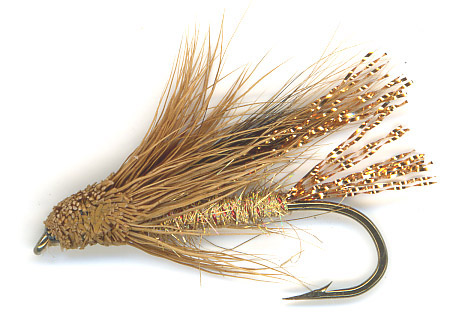Welcome to River Magic
Stillwater Slim on the Line ... April 12, 2011
|
 A REALLY Good FlySome flies work well, some not so well, some not at all. What is that magic ingredient that makes a good fly? Here’s the secret: A good fly appears to be ALIVE!
All bait fishers know that live bait is best. Same with a fly. So how does a fly tyer ensure that a fly will seem alive? And what should an angler look for when buying flies?
To begin with, a good fly should be durable and neatly tied, attributes of all high quality flies. That’s a must. But those attributes do not make a fly look alive. Attributes like mobility, profile, proportion, size, flash, sparkle, eyes, fluorescence, floating or sinking properties, color, and how the fly fishes do. And we are just beginning to experiment with sound, vibration, odor, holography and taste in flies.
Some of these ideas are not really new. I recall some of the old-timers on the St. Mary’s River dousing their salmon flies in sardine oil, and that was close to 40 years ago. Others felt that the odor of mothballs used to protect fly tying materials would repel salmon. Still others felt that washing a freshly cleaned fish in the river was sure to frighten other fish or “put them down”. Similarly, peeing in the river was a definite no-no.
There are good flies and REALLY good flies. A really good fly is one that is taken by a fish in preference to the natural it was tied to imitate. Why does it trigger a take? How is it that a baitfish imitation says “Eat me!” when fished in a huge baitfish school? One reason may be the “wounded minnow” theory. Another may be that it appears to be escaping. Maybe a larger size than the natural will be irresistible to a hungry predator. So, our imitations need not be realistic in the excess, but more interesting and alive. That’s a really good fly.
Some mayfly imitations are tied today with attached nymphal shucks, imitating a mayfly struggling to take free itself and take flight. This fly imitates the odd handicapped mayfly always present in a big hatch. A really good fly looks and acts almost the same as the natural, but somehow different and better.
Let’s not forget about the other end of the line, the end that the angler controls all presentation and movement of the fly. But that’s for another column. I hope this one is thought-provoking and helpful to your fly fishing. At very least it may make your fly fishing more interesting. There’s a lot more to a fly than pattern, size and color.
Another attribute we haven’t mentioned is texture. It seems the texture of clipped deer hair makes for a great fly. Examples are the Muddler Minnow, Buck Bug, Carter Bug and Salmon Bomber. Here’s a fly by Sheet Harbour’s Chris Williams that combines texture with several of the attributes we’ve discussed. Chris tries to see a fly from a fish’s perspective!
Glitter Muddler
Hook – Bronze down-eyed streamer hook, such as Mustad 79580, 3665 or 9672, size 2-10 Thread – Black Tail - Large bunch of copper Krystal Flash Body – Copper Polar UV chenille, clipped short Underwing - Bunch of copper Krystal Flash clipped to reach tip of tail Wing - Pine squirrel tail, sparse Hackle - Light rusty-brown deer hair flared as a collar Head - Light rusty-brown deer hair clipped Muddler style, and then 2 coats of Pro Lac head cement are applied.
Please send comments and suggestions to slim@rivermagic.ca
Please stay on the line … |